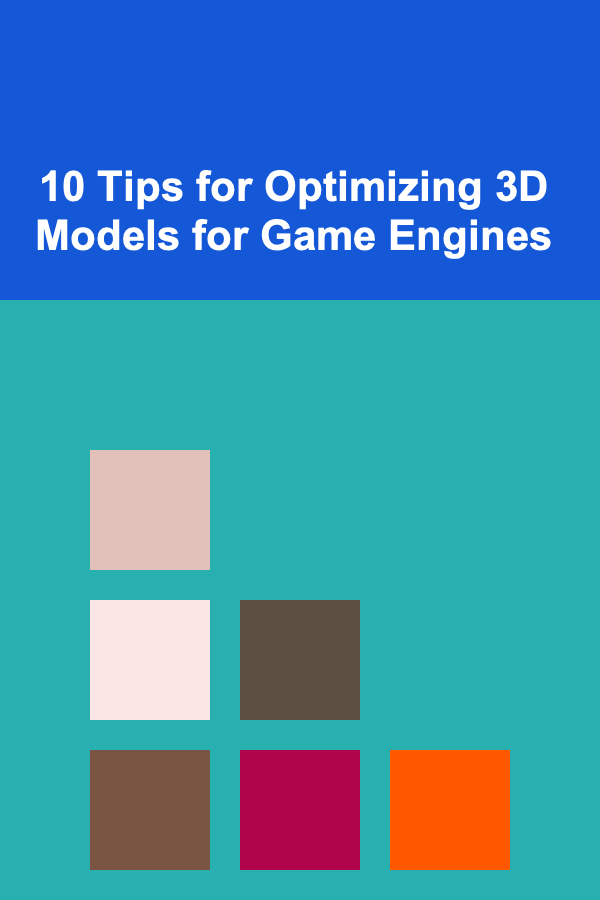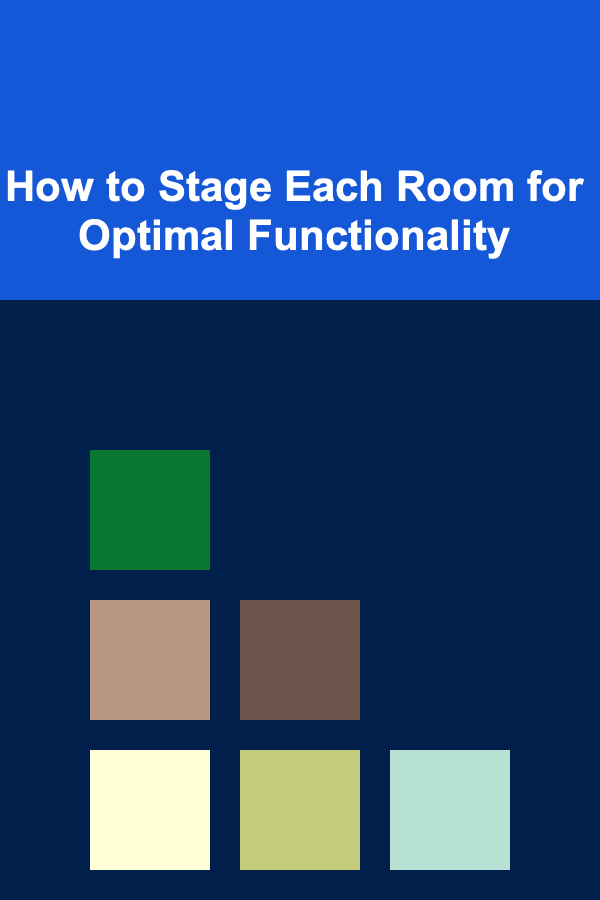
10 Tips for Optimizing 3D Models for Game Engines
ebook include PDF & Audio bundle (Micro Guide)
$12.99$11.99
Limited Time Offer! Order within the next:

When developing games, 3D models are one of the most fundamental elements that bring the game world to life. However, optimizing 3D models for game engines is critical to ensuring that they perform well on different platforms without compromising visual quality. As game engines become more complex and handle increasingly sophisticated graphics, the need for optimization has never been greater. Whether you're working on a high-end AAA title or a mobile game, understanding how to optimize your 3D models is a key aspect of game development.
In this article, we will explore 10 essential tips to help you optimize your 3D models for game engines, ensuring they perform efficiently and look great. From reducing polygon count to making use of the right textures, these strategies will guide you towards creating models that contribute to smooth, responsive gameplay.
Simplify Geometry and Reduce Polygon Count
The first step in optimizing a 3D model for a game engine is to reduce the polygon count without sacrificing the visual integrity of the model. High-poly models can severely affect performance, especially on less powerful hardware like mobile devices.
Key strategies:
- Lod (Level of Detail): Use different versions of the same model with varying polygon counts. The game engine can automatically switch between low-poly models and high-poly models depending on the camera distance.
- Decimation: Use tools like Blender's "Decimate" modifier or ZBrush's "Decimation Master" to reduce the polygon count while preserving the overall shape.
- Retopology: When working with scanned models or models with dense geometry, retopology can help create a cleaner, lower-poly version that still captures the model's key features.
This reduction in geometry can significantly improve rendering performance, especially when you have a large number of assets in your scene.
Efficient UV Mapping
UV mapping is the process of unwrapping a 3D model's surface into a 2D layout for texturing. Efficient UV mapping ensures that textures are applied without distortion and allows for better use of texture space.
Tips for better UV mapping:
- Minimize seams: Place seams in less visible areas, like the underside or the back, to reduce visible texture stretching.
- Use proper scaling: Make sure that the UV islands (individual segments of the unwrapped model) are proportional to their corresponding texture resolution. This ensures that the texture detail is consistent across the model.
- Pack UV islands efficiently: Use the space in the UV layout efficiently to avoid wasted texture space. Tools like "UV Packmaster" can assist in packing your UV islands optimally.
Efficient UV mapping not only improves the quality of textures but also helps in keeping texture sizes manageable, thus contributing to better overall performance.
Optimize Textures
Textures are another crucial factor in the performance of 3D models in a game engine. The larger and more complex the texture, the more resources it will require. Optimizing textures without sacrificing visual fidelity can make a significant impact on game performance.
Strategies for texture optimization:
- Reduce texture resolution: Many times, textures are unnecessarily high-resolution. Reduce the resolution of textures where possible, especially for objects that are not in focus or located far from the camera.
- Texture Atlases: Combine multiple textures into a single texture map, called a texture atlas, to reduce the number of draw calls. This is especially useful when a large number of small objects share the same texture.
- Use compressed textures: Many game engines, like Unreal Engine and Unity, support texture compression formats (e.g., DXT, ASTC). These compressed formats help reduce the memory footprint of textures.
- Optimize texture maps: Make use of normal maps, ambient occlusion maps, and specular maps to simulate complex surface details without using high-poly geometry.
By managing texture resolution, optimizing texture mapping, and utilizing compression, you can achieve high-quality visuals without taxing system resources.
Use Proper Normals and Shading
Normals play a vital role in how light interacts with a model's surface, affecting its appearance in the game engine. Poor normal mapping or shading can lead to undesirable visual artifacts and reduce the realism of your 3D model.
Tips for managing normals:
- Ensure consistent normals: Make sure that normals are pointing in the correct direction. Inconsistent normals can cause issues like incorrect lighting and strange shading.
- Use normal maps: Rather than adding extra geometry to simulate surface details like wrinkles or bumps, use normal maps to fake these details. This allows you to maintain a low-poly count while achieving complex lighting effects.
- Apply smoothing groups: Group faces that should appear smooth and apply smooth shading to them. This ensures that light interacts correctly with curved surfaces.
Correct use of normals and shading can significantly enhance the visual quality of your models without requiring excessive polygons.
Bake Lighting and Ambient Occlusion (AO)
In real-time rendering, calculating lighting and shadows dynamically can be computationally expensive. Baking lighting, including ambient occlusion (AO), can help improve performance by pre-calculating and storing light information.
Baking tips:
- Bake lighting maps: For static objects, bake the lighting and store the results as lightmaps. This reduces the real-time processing load on the engine during gameplay.
- Bake ambient occlusion: Baking AO into your textures adds realistic shading to areas that would be occluded by other objects or geometry. This helps simulate realistic lighting without requiring dynamic lighting calculations.
- Use baking in combination with normal maps: You can combine baked lightmaps and AO with normal maps to simulate realistic lighting and surface details without additional performance costs.
Baking lighting and AO allows for more efficient rendering and helps create visually rich environments, especially in static scenes.
Efficient Rigging and Animation
When creating characters or objects that require animation, efficient rigging and animation optimization are essential to maintaining good performance. Overly complex rigs or excessive keyframes can drastically reduce frame rates.
Rigging and animation optimization tips:
- Limit joint count: The more joints a model has, the more computationally expensive it will be to animate. Keep the rig as simple as possible while maintaining flexibility.
- Use bone weights wisely: Ensure that bones have well-distributed weights across vertices to avoid unnecessary complexity and to maintain smooth deformations.
- Simplify animation: Minimize the number of keyframes in animation, especially for secondary actions that are less noticeable. Consider using bone-driven animation techniques to create complex movements without excessive keyframe data.
Efficient rigging and animation can help reduce CPU/GPU load and improve the performance of character-driven actions.
Optimize Colliders for Physics Interactions
In game development, physics interactions (such as collisions) are an important aspect of gameplay, but complex collider meshes can significantly affect performance.
Collider optimization tips:
- Use simple collider shapes: Instead of using complex mesh colliders, use primitive colliders like boxes, spheres, or capsules whenever possible. These are faster to compute than mesh colliders.
- Convex meshes: If you need to use mesh colliders, make sure they are convex. Non-convex mesh colliders are computationally expensive and may not work well in certain physics engines.
- Collider LOD: For objects in the distance, use simpler collider shapes or reduce the complexity of the collider as the player moves away.
Optimizing colliders ensures that the game engine can process physics interactions quickly, reducing performance bottlenecks.
Use Instancing and Object Pooling
For games with many instances of the same object, like trees, barrels, or enemies, object instancing and pooling are essential for improving performance.
Tips for instancing and pooling:
- Instancing: Use instanced rendering when you have many copies of the same object. This allows the game engine to render multiple instances of an object using a single draw call, reducing overhead.
- Object pooling: Instead of frequently creating and destroying objects, use object pooling to recycle and reuse objects. This reduces the overhead caused by memory allocation and garbage collection.
Both instancing and pooling can drastically improve the performance of games with large numbers of identical objects.
Optimize Level Design and Asset Loading
A well-optimized level design ensures that only the necessary assets are loaded into memory, helping to prevent unnecessary strain on the system. This is especially important for open-world games or large environments.
Optimization tips for level design:
- Occlusion culling: Ensure that objects that are out of view or blocked by other objects are not rendered. Most game engines have built-in occlusion culling systems that automatically manage this.
- Level of Detail (LOD): Implement LOD systems for static objects and terrain. This helps reduce the complexity of models based on distance, ensuring that only lower-resolution models are rendered when the player is far away.
- Asynchronous loading: Use asynchronous loading to ensure assets are loaded in the background without blocking gameplay. This allows the game to load assets as needed, improving load times and reducing in-game stutter.
Efficient level design and asset loading ensure smoother gameplay, especially in expansive environments.
Test and Profile Performance Regularly
Optimization is an iterative process that requires constant testing and profiling to identify bottlenecks and areas for improvement. Regularly testing your game and profiling its performance can help you track your optimization progress.
Testing tips:
- Use game engine profiling tools: Both Unity and Unreal Engine offer profiling tools that can help identify performance issues in real-time.
- Test on multiple platforms: Optimize for a wide range of devices to ensure that the game performs well on different hardware configurations.
- Check frame rate and memory usage: Monitor both frame rate and memory consumption to ensure that optimization efforts are effective.
Frequent performance testing and profiling will help you catch and fix issues early in the development process, preventing performance degradation later.
Conclusion
Optimizing 3D models for game engines is a critical step in ensuring your game runs efficiently while still looking great. By following the tips outlined in this article, such as reducing polygon count, optimizing textures, using proper rigging techniques, and leveraging advanced tools like LOD and instancing, you can create assets that contribute to smooth, high-quality gameplay.
Remember that optimization is an ongoing process. By continuously testing, profiling, and adjusting your assets, you can achieve a balance between visual quality and performance that meets the needs of your game and its players.
Reading More From Our Other Websites
- [Home Family Activity 101] How to Make Homemade Family Holiday Cards and Gifts Together
- [Star Gazing Tip 101] Beyond the Night Sky: Crafting a Fresh Stargazing Adventure for First-Timers
- [Home Rental Property 101] How to Invest in Multiple Rental Properties for Increased Income
- [Organization Tip 101] How to Set Realistic Meal Prep Goals for Yourself
- [Home Budget 101] How to Teach Your Kids About Budgeting and Saving at Home
- [Home Party Planning 101] How to Decorate Your Home for a Romantic Date Night Party
- [Rock Climbing Tip 101] From Crack to Crux: Techniques to Conquer the Hardest Trad Moves
- [Small Business 101] How to Navigate Trademark Registration for Small Custom Apparel Brands
- [Home Soundproofing 101] How to Soundproof a Home for Ultimate Privacy
- [Personal Care Tips 101] How to Apply Blush for Mature Skin: Tips for a Natural Look

How to Enhance Your Intuition with Brain Science
Read More
How to Stage Each Room for Optimal Functionality
Read More
How to Test Your Product for Performance and Scalability
Read More
How to Use Holiday Florals to Brighten Your Home
Read More
How To Learn a Language Through Cooking
Read More
10 Tips for Camping with Dogs: Safety and Fun
Read MoreOther Products

How to Enhance Your Intuition with Brain Science
Read More
How to Stage Each Room for Optimal Functionality
Read More
How to Test Your Product for Performance and Scalability
Read More
How to Use Holiday Florals to Brighten Your Home
Read More
How To Learn a Language Through Cooking
Read More